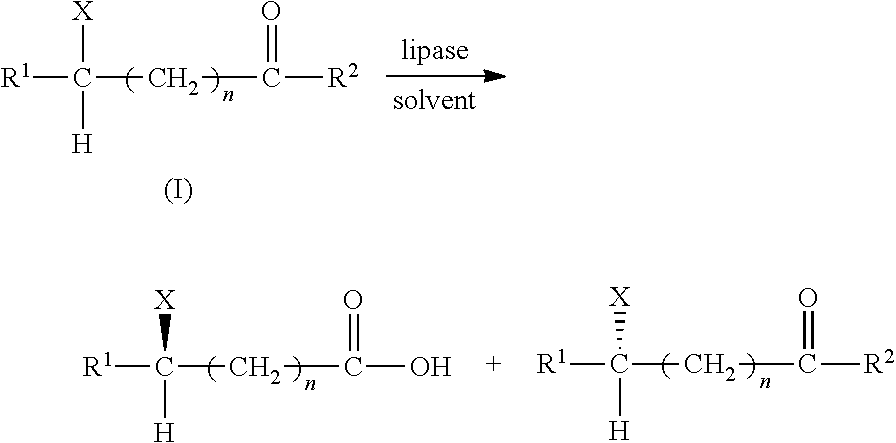Method for producing an optically active compound
- Summary
- Abstract
- Description
- Claims
- Application Information
AI Technical Summary
Benefits of technology
Problems solved by technology
Method used
Image
Examples
example
Chemicals used in the Following Examples
1. Substrate:
[0033]A substrate specified in Table 1 was prepared by subjecting two reactants (I) and (II) specified in Table 1 for each substrate to reaction at room temperature or 55° C. When the reactant (II) was N,N-carbonyldi(1,2,4-triazole) or N,N-carbonyldiimidazole, the reaction was conducted at 55° C.
TABLE 1ReactantNo.Racemic Substrate(I)(II)(1)N-2-phenylpropionyl-2-phenylpropionic acidN,N-carbonyldi(1,2,4-1,2,4-triazole(available from Flucktriazole)(available fromCo.)Aldrich Co.)(2)N-2-phenylpropionyl-2-phenylpropionic acid4-bromopyrazole(available4-bromopyrazolefrom Aldrich Co.)(3)N-2-phenylpropionyl-2-phenylpropionic acid4-methyl-pyrazole4-methylpyrazole(available from AcrosCo.)(4)N-2-phenylpropionyl-2-phenylpropionic acid4-nitropyrazole(available4-nitropyrazolefrom MatrixScientific Co.)(5)N-2-phenylpropionyl-2-phenylpropionic acidN,N-carbonyldiimidazole(imidazole)(6)N-2-phenylpropionyl-2-phenylpropionic acidpyrazole (availablepyraz...
examples 1-55
Hydrolytic Resolution of the Azolide Substrates (Ex1˜Ex55)
[0041]The hydrolytic resolution of the substrate in each of Ex1˜Ex55 was conducted and analyzed by the following steps:
1. Preparation of Reaction Solution:
[0042]A substrate solution with a concentration of 3 mM was prepared by mixing an organic solvent saturated with water and a substrate specified in Table 2 for each Example.
[0043]An amount of a lipase specified in Table 2 for each Example was added into 10 mL of the substrate solution so as to form a reaction solution for each Example. The reaction solution of each Example was subjected to hydrolytic resolution at a reaction temperature for a predetermined time period (see Table 2).
2. Sampling and Analyzing:
[0044]Aliquot (200 μL) of reaction solution was taken out at predetermined time intervals and was subjected to HPLC analysis using a selected column under analyzing conditions and instrument settings shown in Table 2 and 3. The HPLC analysis results were used to calculat...
examples 56-95
Alcoholytic Resolution of Azolide Substrates (Ex56˜Ex95)
[0053]The alcoholytic resolution of the substrate for each of Ex56˜Ex95 was conducted and analyzed by the following steps:
1. Preparation of Reaction Solution:
[0054]For each Example (with reference to Table 5), anhydrous methyl t-butylether was mixed with a substrate so as to obtain a substrate solution with a concentration of 3 mM, and with an alcohol so as to obtain 100 mM of an alcohol solution.
[0055]Novozym and the alcohol solution were added into 10 mL of the substrate solution so as to form a reaction solution for each Example. The reaction solution was subjected to alcoholytic resolution at a temperature for a predetermined time period (see Table 5).
2. Sampling and Analyzing:
[0056]Sampling and analyzing (the analysis conditions and settings are shown in Table 5) of Ex56-Ex95 were conducted in the same manner as those of Ex1˜Ex55. The calculated results of the Xt value, the E value and the ee value according to the above f...
PUM
 Login to View More
Login to View More Abstract
Description
Claims
Application Information
 Login to View More
Login to View More - R&D
- Intellectual Property
- Life Sciences
- Materials
- Tech Scout
- Unparalleled Data Quality
- Higher Quality Content
- 60% Fewer Hallucinations
Browse by: Latest US Patents, China's latest patents, Technical Efficacy Thesaurus, Application Domain, Technology Topic, Popular Technical Reports.
© 2025 PatSnap. All rights reserved.Legal|Privacy policy|Modern Slavery Act Transparency Statement|Sitemap|About US| Contact US: help@patsnap.com



